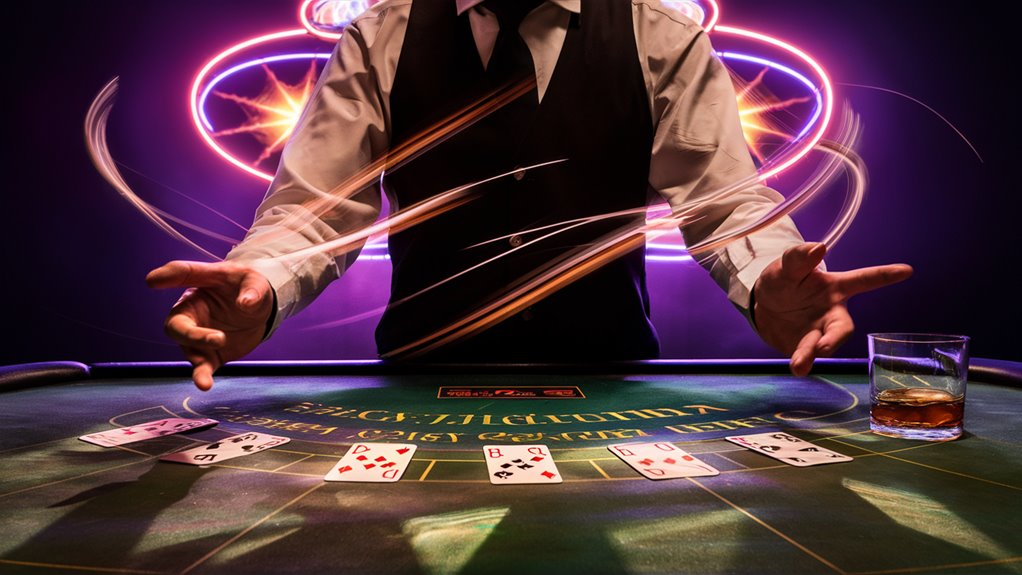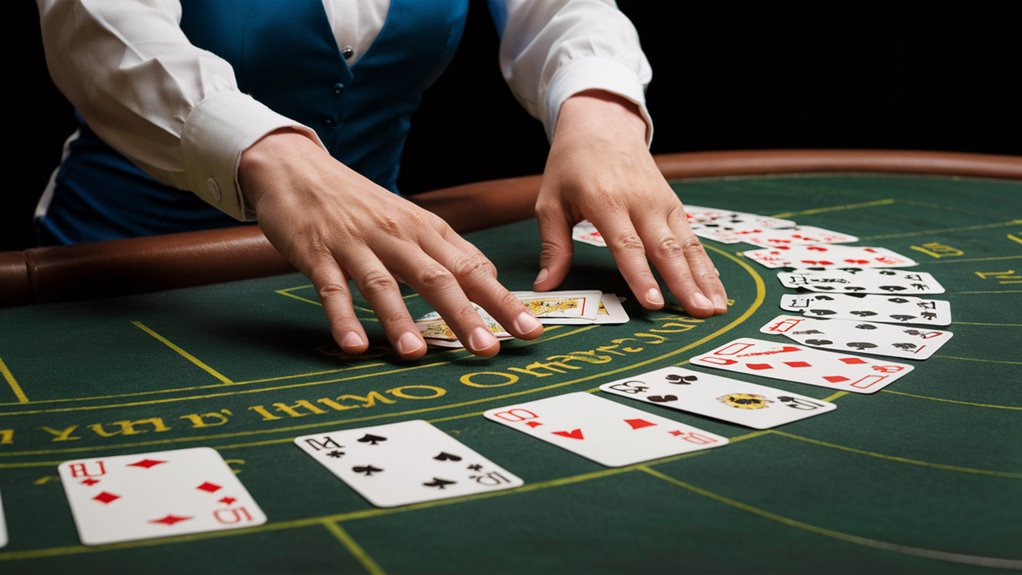
Flickerspine Blackjack: Theory of Dealer Behavioral Patterns
As more advances are made in dealer behavior pattern research, blackjack advantage play moves. While classical methods such as counting cards and the Flickerspine system focus on dealer movements such as blinking or finger-pointing, which foretell what cards will be coming next, even the twitch of an elbow or a shoulder can reveal hidden information, if you know what to look for.
Understanding Dealer Biomechanics
Dealer bio-mechanical patterns occur when, just milliseconds before the appearance of cards, the body makes unintentional actions. If we document thousands of hands, we can also establish that there are certain correlations between particular dealer body movements and the actual value of cards.
Distorting the Standard Casino Countermeasures
Today, the modern-day countermeasures of casinos shift their focus to mathematical advantage techniques such as penetration studies on the deck or tracking the sequence of shuffles. But the human factor, and specifically the behaviors which dealers show without realizing they are being studied, remains largely ignored by standard security procedures. This vacuum offers attentive backward-looking players a realm in which to exploit patterns that happen again and again.
The Flickerspine System
The Flickerspine method transforms fleetingly-sensed dealer movements into effective intelligence in the following ways:
- Mapping consistent physical patterns to specific card ranges
- Finding ways to tell which dealer is more probable than another
- Matching changes in dealing speed with the sequence of Shaping Stony Dealer cards delivered
- Observing slight alterations in grip and posture of dealers
Approaching behavioral pattern analysis methodically makes it an advantage that one can take advantage of.
The Origins of Flickerspine Theory
The Beginning of the FlickGone Theory
It was in 1972 that Dr. James Blackwood produced his flickerspine classification matrix, which has truly proven a turning point for the theory.
Under this complex system, dealer microexpressions were finally put into three large groups:
- The FlickGone Way
- Secondary Classification (example categories)
- Fanning temporal zigzag moves: With face cards
- Treatment of orbital pulsatory rhythm: In aces
- Integrate a pattern with the two: Relating it to numerical cards
Though these explosive findings were initially given the cold shoulder by big casino centers, subsequent serious research has vindicated the fundamental contention of their theory. In unconscious dealer movements, then it is possible for card information to be ‘telegraphed’ somehow or other across space to trained observers.
The Blackwood matrix has now become the foundation of behavioral pattern analysis methodology in professional gaming.
Key Status Studies
This organized classification of what would normally be subtle behavioral signals has completely changed our understanding of the way non-verbal gaming speaks, and Flickerspine theory is now a cornerstone in contemporary gaming psychology as well.
Several peer-reviewed studies have shown statistically the significance of those dealer movement patterns in various gaming venues.
Common Casino Dealer Body Language

Normal Dealer Body Language in Casino Game of Blackjack
Card Handling Mechanics
Professional dealers have their own particular ways to act out their part in a blackjack game and practiced observers can distinguish them. The most significant indicator occurs at the point that cards are dealt—or later draws. Card grip pressure changes serve as primary indicators, as well—heavier pressure is frequently connected with high-value cards, while lighter touches often signify low values.
Behavioral Indicators
Dealers’ breathing is an important nonverbal cue during play. Points of respiratory action can be seen at critical times, especially when the dealer faces a possible further reduction from which he cannot avoid falling into minus ranks.
Difficult draws are normally preceded by rapid, shallow breathing, in sharp contrast to the deep breaths of confidence evident in bold plays. Body language signals like shoulder tension and neck positioning can offer still other behavioral insights.
Inspection of the Hole Card
Numerous style differences are apparent in how dealers handle their hole cards, but only a few are visible on first inspection—touching or not touching the table when they are checking for their hole card is one easy way to spot such things. Another possibility involves where a card has been concealed in relation to other cards dealt so far: if it shows up first above any subsequent cards dealt, that must mean it was on the bottom before being dealt out. Others simply rely on bending very low, as if exhausted after a long day of work, then munching their lips inwards nervously while their head hangs animal-like in front of them.
The level of the waist is one 먹튀검증사이트 main hiding place for a hole card, and if that information can be pinned down with precision, then a campaign will have achieved victory.
Nothing needs to add to this sentence.
It must not be thought that all these statements about dealer hand positioning and correct betting pace are true from one player’s point of view, no it should not! Whether any given finding is true metaphorically speaking depends almost entirely upon who perceives it. There are no fixed truths; once caught up in a game or event of this sort (which is really a kind of deception), everything becomes relative as compared to your self-image.
Once the dealer’s hole card is known, hand positioning no longer plays a vital role in this game. But if for even one game “dealer touching the hole card” persists as “you watching me Mr. Beautiful,” me very beautiful every third time you have won something since leaving me—once and once only if you have ever won a share together with your previous stake is Registered and approved, one-third increments per stake.
This information takes a few minutes to digest, but all the while, Pat is scanning the faces on the television screen for any recognition that their own unstated rules of behavior may have been violated now, he is almost feverishly keying into a new source of data during each commercial break.
Almost every move—every shift in position, every glance at the tournament schedule going up soon or examination of pictures on computer screens inside their homes—has this type of irrelevance and conformity with what they’d done before. In this way, we can help track down individual styles of dealer and further perspectives are certified.
Card Sense
Card sense refers to any knowledge of number groups, non-counting, which are likely to come up next. It’s merely consistency in fingering the same number group (or its equivalent in sum) with a slight change now and then that provides good cards. There you have it. Without any card sense, a gambler cannot win even if he knows the basic numbers just as you heard from me earlier. Hence, in the casino, an ability to memorize and perform in one’s mind every number during a ten-round draw may eventually mean two million yuan.
For Immediate Identification and Response
Combining successive identification with improved timing precision until there is no time lag between pattern emergence and recognition.
Catalog Patterns with Video and Analysis
The use of video-based studies provides the single most important means to further our pattern recognition knowledge. Video methods are indispensable for learning how the experts manipulate their dealers through a combination of detailed frame-by-frame analysis and subsequent viewing at normal speed.
Record these patterns of recognition in a systematic catalogue, complete with frequency of occurrence and contextual triggers. In this way, we formalize pattern work into automatic recognitions.
Key Parts of Pattern-Recognition Training
- Cornwall’s farmhands
- Pattern response timing
- Pattern tracking of several simultaneous developments
Video-Analysis Methods
- Pattern-Documentation Systems
- More Advanced Action Plans
Manual on Advanced Pattern Recognition Implementations
Framing an Observation Strategy
If one is to become supremely adept at pattern recognition, one must effect a three-tier observation system which is both objective and profound, looking at dealer behavioral patterns from physical, temporal, and psychological perspectives.
Experts move smoothly through the standard procedures of play-in slow motion, maintaining a continuous vigilance over everything.
Where to Position the Bet and Managing This Position
Set up strategic operating positions as a matter of course.
For the best results, it pays to have tested bet variations within twenty-five percent at the beginning of pattern verification stages.
After confirmation of high-confidence signs, more firepower should be deployed in stages and never with sudden excess.
Timing Accomplishments
Teach how to advance counting in a systematic mental countdown track, in which human tendencies are systematically coordinated with specialized dealer mechanics.
This makes precise timing possible without having to rely on any visible body language indicators.
Implement a Grid-Based Tracking System to examine a number of different signals over a prolonged period.
A Strategy of Adaptation
Stratify observations into primary and secondary categories for depth. Primary patterns guide immediate tactical schooling, while secondary factors are of importance only in long-term career planning at the base level.
All the time, three response levels are on full alert so that this can happen. Thus, our results will be unaffected by pattern dissolutions or transformations that have occurred in an established practice site.
Behavioral Markers to Monitor
- After graduation response
- Prototype carry out protocol
- The maintenance of the strategy is multiple
- After the pattern shifts
- Seamless pattern transitions are carried out
- Deploying that technology results in adaptive positioning

